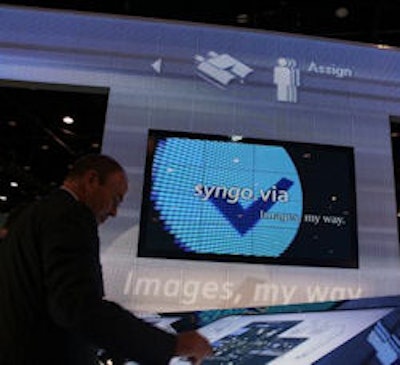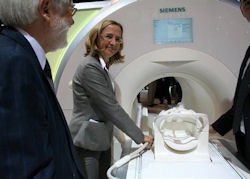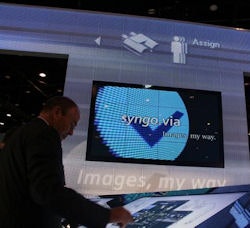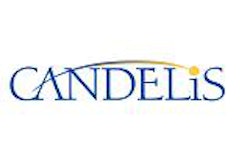
CHICAGO - A brace of new MRI scanners, new advanced visualization and PACS software, and new advances in CT, women's imaging, and ultrasound are highlights in the RSNA booth of Siemens Healthcare of Malvern, PA, at this year's conference.
MRI
A week prior to the RSNA show, Siemens announced that it was launching two new MRI scanners, the 1.5-tesla Magnetom Aera and the 3-tesla Magnetom Skyra.
 |
| Magnetom Skyra is a 3-tesla MRI scanner being launched at this year's meeting. |
The major selling point with the new systems are their 70-cm magnet bores, compared to 60-cm bores on older Siemens scanners, other than the Magnetom Espree and Verio. Another major new development is their incorporation of the latest generation of Total image matrix (Tim), the company's coil and radiofrequency technology, called Tim 4G. Tim 4G now features a standard configuration of 48 channels, with Aera users able to upgrade to 64 channels and Skyra users able to upgrade to either 64 or 128 channels. All configurations come with 204 coil elements.
Both scanners are pending U.S. Food and Drug Administration (FDA) 510(k) clearance, and Siemens expects to begin shipping in the second quarter of 2010.
Tim Dot (day optimizing throughput engine) is new software designed to make scanning more automated and improve throughput. Siemens says that beta sites using the software have experienced a 30% productivity increase, and users can choose either high-resolution or high-speed exams. Other customization protocols include built-in guidance for technologists and the choice of different languages for prerecorded voice commands for patients.
Dot will ship with all Aera and Skyra scanners, and in 2011 all Siemens scanners with Tim will be able to upgrade to the technology.
Other new MRI developments include a Tim-compatible dockable table with an integrated, removable 32-channel spine coil, and DirectRF, a new design that integrates all RF transmit and receive components at the magnet, eliminating analog cables for true signal purity, and TimTX TrueForm, which optimizes RF transmission.
Healthcare IT
At RSNA 2009, Siemens is promoting its upcoming syngo.via software, designed to be a platform for enhanced multimodality reading, networking, and advanced visualization. Among its features are automated case preparation to greatly reduce reading time and structured case navigation across multiple specialties, including cardiology, oncology, and neurology.
syngo.via also is designed to integrate imaging devices and information technology from across Siemens' radiology portfolio, as well as modalities from other vendors.
 |
| syngo.via is a platform for reviewing and reading medical images based on advanced visualization. |
Several syngo.via applications are pending 510(k) clearance from the FDA. The software currently is in beta testing at 13 locations. Siemens hopes to make syngo.via available in the U.S. by mid-2010.
Siemens also is highlighting syngo.plaza, a new PACS product that combines 2D, 3D, and 4D reading and integrates with syngo.via. The system features case-specific reading and automatically accesses 2D, 3D, or 4D applications, remembering users' preferences and sorting images accordingly.
In addition, reading tools and layouts can be adapted to users' daily requirements and preferences. syngo.plaza also is pending FDA 510(k) review and is not yet commercially available.
CT
In CT, Siemens is addressing dose reduction concerns by highlighting a new iterative reconstruction technique called iterative reconstruction in image space (IRIS). IRIS offers a 60% reduction in dose, and the company reports that users of its Somatom Flash CT scanner are conducting coronary CT angiography studies at radiation doses of 0.85 mSv. For pediatric heart scans, the company has recorded doses as low as 0.05 mSv.
Siemens is reporting that Flash achieves the dose reductions through a proprietary flash scanning mode that does not require the slice overlap found on most multislice CT scanners. The company also recommends special pediatric scanning protocols at 80 kV.
Siemens has been touting the benefits of dual-energy scanning since it launched its first dual-source scanner. The company to date has released 12 clinical applications for dual-source imaging, and some sites are using it as a routine scanning mode.
Molecular imaging
Siemens' Biograph mCT molecular CT scanner continues to lead the company's molecular imaging segment. According to the company, an increasing number of healthcare facilities are opting for the Biograph mCT because of its ability to be used together or separately as a high-definition PET imager for oncology applications or as a CT system that can be configured with up to 128 slices.
Siemens also is showing Symbia.net, which is pending FDA 510(k) clearance. The new client-server technology for SPECT and SPECT/CT imaging applications is designed for enhanced processing and reading any time from multiple locations.
Symbia.net's advanced automation features allow for quality control and quality assurance checks when SPECT and SPECT/CT systems are not in use to avoid delays or downtime.
Ultrasound
In ultrasound, Siemens is highlighting advances in its Acuson S2000 ultrasound platform.
Acoustic radiation force imaging (ARFI), virtual touch tissue imaging (not yet available in the U.S.), and virtual touch tissue quantification (not yet available in the U.S.), are among the features coming to Acuson S2000. The technologies are designed to interrogate and measure mechanical strain properties or stiffness of tissue, which correlate with pathology.
Virtual touch tissue quantification, for example, would provide a numerical value related to tissue stiffness at a precise anatomical location to possibly identify early stages of liver diseases causing cirrhosis.
In addition, Siemens introduced its new women's imaging ultrasound line at RSNA 2009, with dedicated women's imaging versions of the Acuson S2000 and Acuson X300 scanners. The editions offer a range of applications designed to optimize workflow in maternal-fetal medicine and routine clinical environments.
Siemens also is showing the Acuson S2000 automated breast volume scanner (ABVS). The system would take operator dependence and variability out of breast ultrasound and reduce acquisition time to approximately 10 minutes or less.
The system provides coronal views of the breast to increase diagnostic confidence, along with semiautomated reporting and comprehensive BI-RADS reporting capabilities to enhance clinical workflow.
Women's imaging
Siemens is reporting to RSNA visitors that it is making progress on the premarket approval (PMA) supplement with the FDA for its Mammomat Inspiration full-field digital mammography (FFDM) system. Some 400 units have been installed in the rest of the world, and the company hopes to receive the regulatory go-ahead in the first quarter of 2010 for U.S. shipments.
Inspiration features a generator built into the system's gantry, designed to make the unit easier to site in small spaces. The company has also changed to a new digital detector supplier, due to the need to have a detector with a faster readout speed to support digital breast tomosynthesis applications in the future.
Tomosynthesis is already available on the system in the rest of the world, and the company is starting the regulatory process with the FDA to receive approval in the U.S. Siemens estimates that it is probably a couple years away from being able to ship Inspiration as a 3D tomosynthesis system in the U.S.
Until then, the 2D version of Inspiration is tomo-ready, and Siemens will be able to upgrade customers who buy a system now with just a software upgrade and the installation of a wire in the unit.
In other new Inspiration features, Siemens is touting a new removable paddle on Inspiration that's made from a softer type of plastic, as well as a mood-lighting option to make patients feel more comfortable in the imaging suite. The company is also touting syngo MammoReport, workstation software that has the ability to display 3D ultrasound and 3D MRI breast images alongside FFDM data, as well as its MammoTest prone breast biopsy table.
X-ray
Within the x-ray section of Siemens' booth, the company's Artis zeego floor-mounted angiography system is being highlighted. The company is talking up a new campaign designed to promote interventional oncology applications for the system as an alternative to CT-guided biopsy. These include transcatheter-based therapy like chemoembolization, and ablative therapies like radiofrequency ablation (RFA), in which tissue is heated to destroy tumors.
In other clinical applications, Siemens is discussing functional imaging using Artis zeego, as well as Neuro parenchymal blood volume (PBV) IR, for performing functional imaging in the interventional suite. Siemens says that Neuro PBV IR offers an advantage over existing standard of care by enabling stroke patients to be sent directly to an interventional suite, where they can be diagnosed and immediately treated, if necessary, without being transfered again. Neuro PBV IR is being shown as a work-in-progress pending 510(k) clearance.
For the Ysio wireless digital radiography (DR) system, Siemens is demonstrating the flexibility of the unit's floating tabletop, which supports a 660-lb patient weight limit. The company is talking up an Ysio option for its Luminos DRF fluoroscopy system that enables customers to use the unit for fluoroscopy studies in the morning and DR exams in the afternoon, thus improving the efficiency of their x-ray room.
By Brian Casey and Wayne Forrest
AuntMinnie.com staff writers
December 1, 2009
Related Reading
Siemens installs first Definition Flash in U.K., November 25, 2009
Siemens RSNA launches to include 3D platform, MRI scanners, November 24, 2009
Siemens adds Flash CT install, November 19, 2009
Siemens installs first Verio MRI scanner in Texas, November 6, 2009
Candelis/Siemens ink distribution deal, November 4, 2009
Copyright © 2009 AuntMinnie.com



















